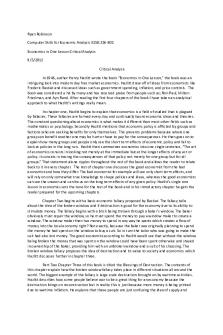Lesson 26 - Civil Disobedience (Part One) PDF

| Title | Lesson 26 - Civil Disobedience (Part One) |
|---|---|
| Course | Introductory Philosophy: Social and Political Issues FW |
| Institution | University of Guelph |
| Pages | 2 |
| File Size | 79.6 KB |
| File Type | |
| Total Downloads | 5 |
| Total Views | 145 |
Summary
Bromhall...
Description
Civil Disobedience (Part One)
If our rights are systematically violated, or we are otherwise in an oppressive situation, then we will likely want to engage in behaviour in change our lot Typically, there are two ways we can go about securing systemic change: o Reform o Revolution
Reform
When someone seeks reform, typically they seek incremental, deliberate change from within the existing power structure in order to improve it o Peaceful o Without violent revolution How might someone or a group of people go about seeking reform? o Protesting o Interest groups o Strikes o Legislation o Referenda
Revolution
When someone seeks revolution, typically they are seeking drastic, widespread change and reject the existing power structure, replacing it with a new one o E.g., V.I. Lenin who violently overthrew the existing Russian government How might you go about organizing a revolution? o Uprising o Coup d’etat (military uprising against government) Dr. Martin Luther King Jr. sought a third way employing the quick, drastic change of revolution but with the peaceful and conciliatory nature of reform – he called this nonviolent direct action
Non-Violent Direct Action
King’s central claim in his letter was that non-violent direct action is a morally obligatory response to oppression and injustice, not just for those who are oppressed, but for everyone For King, a campaign of non-violent direction action has four steps: o Collection of the facts to determine whether injustice is alive o Negotiation o Self-purification o Direct action Injustices – King notes that Birmingham is the most notoriously segregated city in the USA, and injustices were alive and well
Negotiation – King underscores a crucial first step of a non-violent campaign, which is a good-faith attempt to negotiate with the powers-that-be o Negotiated and made an agreement that racial signs would be taken down o The other side didn’t follow through, and the signs were left up Self-purification – the most unobvious step, but also the most crucial; in this step, demonstrators consider whether they are able to follow through on the demands of nonviolent direct action (especially the non-violent part) o Those who would tend towards violent revolution are expunged Direct action – this must occur because by the time it is necessary, there is no more time left for small, incremental changes o In direct action, you engage in behaviour meant to severely disrupt the everyday goings-on of the public; this is not without purpose though o The purpose of direct action is to bring about negotiation o The creative tension caused by direct action brings those who were unwilling to negotiate back to the table, and much more willing to make concessions By engaging in direct action, one brings attention to one’s cause by being a pain in the ass – but a peaceful pain in the ass Thus, we can see how non-violent direct action is supposed to be a middle ground between reform and revolution o Through direct action, you force society to pay attention to your concerns, and since your means are non-violent, they can’t be slandered as easily Two concerns are left for King – the relationship of non-violent direction action to the law and the apparent extremism of non-violent direct action o Next class...
Similar Free PDFs

Civil Disobedience - Grade: B+
- 7 Pages

Civil Disobedience Movement
- 11 Pages

Civil Disobedience Movement
- 3 Pages

Economics in one lesson
- 2 Pages

Federalism - Part One
- 2 Pages

Economics in one lesson
- 33 Pages

Part 8 Offer - Civil
- 4 Pages
Popular Institutions
- Tinajero National High School - Annex
- Politeknik Caltex Riau
- Yokohama City University
- SGT University
- University of Al-Qadisiyah
- Divine Word College of Vigan
- Techniek College Rotterdam
- Universidade de Santiago
- Universiti Teknologi MARA Cawangan Johor Kampus Pasir Gudang
- Poltekkes Kemenkes Yogyakarta
- Baguio City National High School
- Colegio san marcos
- preparatoria uno
- Centro de Bachillerato Tecnológico Industrial y de Servicios No. 107
- Dalian Maritime University
- Quang Trung Secondary School
- Colegio Tecnológico en Informática
- Corporación Regional de Educación Superior
- Grupo CEDVA
- Dar Al Uloom University
- Centro de Estudios Preuniversitarios de la Universidad Nacional de Ingeniería
- 上智大学
- Aakash International School, Nuna Majara
- San Felipe Neri Catholic School
- Kang Chiao International School - New Taipei City
- Misamis Occidental National High School
- Institución Educativa Escuela Normal Juan Ladrilleros
- Kolehiyo ng Pantukan
- Batanes State College
- Instituto Continental
- Sekolah Menengah Kejuruan Kesehatan Kaltara (Tarakan)
- Colegio de La Inmaculada Concepcion - Cebu








